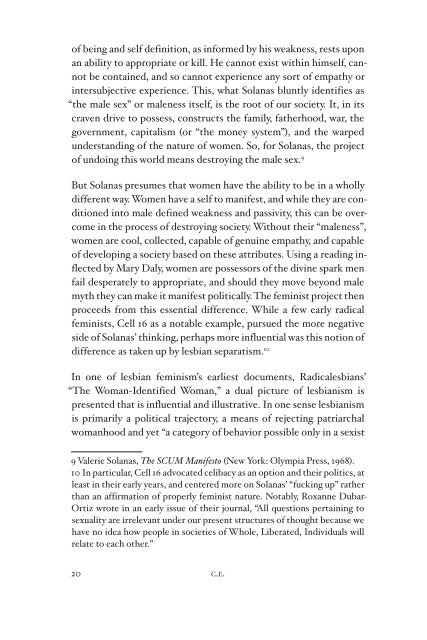Lies: A Journal of Materialist Feminism - Libcom
Lies: A Journal of Materialist Feminism - Libcom
Lies: A Journal of Materialist Feminism - Libcom
You also want an ePaper? Increase the reach of your titles
YUMPU automatically turns print PDFs into web optimized ePapers that Google loves.
<strong>of</strong> being and self definition, as informed by his weakness, rests upon<br />
an ability to appropriate or kill. He cannot exist within himself, cannot<br />
be contained, and so cannot experience any sort <strong>of</strong> empathy or<br />
intersubjective experience. This, what Solanas bluntly identifies as<br />
“the male sex” or maleness itself, is the root <strong>of</strong> our society. It, in its<br />
craven drive to possess, constructs the family, fatherhood, war, the<br />
government, capitalism (or “the money system”), and the warped<br />
understanding <strong>of</strong> the nature <strong>of</strong> women. So, for Solanas, the project<br />
<strong>of</strong> undoing this world means destroying the male sex. 9<br />
But Solanas presumes that women have the ability to be in a wholly<br />
different way. Women have a self to manifest, and while they are conditioned<br />
into male defined weakness and passivity, this can be overcome<br />
in the process <strong>of</strong> destroying society. Without their “maleness”,<br />
women are cool, collected, capable <strong>of</strong> genuine empathy, and capable<br />
<strong>of</strong> developing a society based on these attributes. Using a reading inflected<br />
by Mary Daly, women are possessors <strong>of</strong> the divine spark men<br />
fail desperately to appropriate, and should they move beyond male<br />
myth they can make it manifest politically. The feminist project then<br />
proceeds from this essential difference. While a few early radical<br />
feminists, Cell 16 as a notable example, pursued the more negative<br />
side <strong>of</strong> Solanas’ thinking, perhaps more influential was this notion <strong>of</strong><br />
difference as taken up by lesbian separatism. 10<br />
In one <strong>of</strong> lesbian feminism’s earliest documents, Radicalesbians’<br />
“The Woman-Identified Woman,” a dual picture <strong>of</strong> lesbianism is<br />
presented that is influential and illustrative. In one sense lesbianism<br />
is primarily a political trajectory, a means <strong>of</strong> rejecting patriarchal<br />
womanhood and yet “a category <strong>of</strong> behavior possible only in a sexist<br />
9 Valerie Solanas, The SCUM Manifesto (New York: Olympia Press, 1968).<br />
10 In particular, Cell 16 advocated celibacy as an option and their politics, at<br />
least in their early years, and centered more on Solanas’ “fucking up” rather<br />
than an affirmation <strong>of</strong> properly feminist nature. Notably, Roxanne Dubar-<br />
Ortiz wrote in an early issue <strong>of</strong> their journal, “All questions pertaining to<br />
sexuality are irrelevant under our present structures <strong>of</strong> thought because we<br />
have no idea how people in societies <strong>of</strong> Whole, Liberated, Individuals will<br />
relate to each other.”<br />
20<br />
C.E.

















